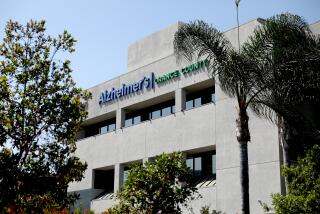‘Miracle Cure’ for Back Pain Has Lots of Appeal--and Skeptics
- Share via
About eight in 10 Americans suffer from back pain at some point in their lives, and many try everything from bed rest to spinal surgery for relief--with mixed results. Millions are still hurting, and desperate for answers that doctors often can’t provide.
Of the many therapies that are touted in newspaper and radio advertisements, perhaps the most visible in Southern California is a treatment program known as DiskCure. Ads for DiskCure promise a “breakthrough” drug treatment at a clinic known as the Institute for Neurological Research. “Freedom from pain. At last. Without surgery,” says the clinic’s Web site.
The clinic, operated by Dr. Edward Tobinick, a dermatologist and internist, is housed at 100 UCLA Medical Plaza, in the heart of one of the world’s premier teaching hospitals. The clinic’s Web site also asserts that the treatment, using “a new class of biotechnology medications,” has brought relief to patients with various forms of back, neck or leg pain associated with disk disease.In an interview, Tobinick said his patients usually are given a single injection, applied under the skin. “It’s a miracle cure, a magic bullet,” he said.
Some other pain specialists are skeptical, however. Decades of research have failed to yield a single, all-purpose answer for back pain, they say, and doctors often don’t even agree on what’s causing the pain.
Tobinick said his clinic, with locations at UCLA and in Newport Beach, has treated about 1,500 people and that about two out of every three patients have had “a significant improvement in their symptoms.” The clinic charges about $2,200 for a one-time treatment and consultation. Some patients may require more than one treatment, he said.
Kathleen McGarry, of Santa Maria, said she was “flat on her back for nine months with back and leg pain” and had gone from doctor to doctor before visiting Tobinick’s clinic in October. “Within two minutes of the treatment, the pain was gone,” said the 55-year-old administrative assistant, one of several former patients whose names were provided by Tobinick. “That was six months ago, and I’m back to work; I’m fine.”
Tobinick is reluctant to discuss the DiskCure drug regimen in detail. He would not name the medications he uses, saying only that they are anti-inflammatory agents that moderate the body’s immune response. The drugs are approved by the Food and Drug Administration, he said, but not specifically for treatment of back pain.
It’s not unusual for doctors to prescribe a drug to treat a condition other than that approved by the FDA. For example, physicians experimented with injections of botulism toxin, or Botox, to smooth wrinkles, for years before the FDA finally approved the drug for that purpose last month.
Typically, doctors making use of an FDA-approved drug in a novel way share their findings, by presenting data at professional conferences or publishing their research in medical journals: This is how other doctors learn about and evaluate new uses for medications. Tobinick acknowledges that, so far, he has done neither. No studies of the drugs’ effectiveness in treating back pain in humans have yet been made public, he said.
But Tobinick pointed to experiments in laboratory animals that have shown that the anti-inflammatory drugs he is using can be effective in treating disk injury. The studies were done in pigs and in rodents, he said, while declining to cite any specific studies.
Dr. James N. Weinstein, an orthopedic surgeon at Dartmouth University’s Medical School and editor of the medical journal Spine, said he was aware of two such studies. In one, published in the April 15, 2001, issue of Spine, Swedish researchers reported that the drugs etanercept (whose trade name is Enbrel) and infliximab (Remicade) limited nerve damage and inflammation after disk injury in a group of pigs. In the other, Japanese doctors found that a similar anti-inflammatory drug limited disk damage in rats.
But, Weinstein noted, “studies in animals in no way suggest that the drugs are efficacious for all back problems. You would have to do clinical trials in humans to determine that.”
Tobinick said he is organizing a human trial. The experiment, he said, will include 20 people with back and leg pain: Ten will receive an injection of the principal drug used in the DiskCure treatment and 10 will get a placebo injection, of saline solution.
Says Tobinick: “We are going to publish a big article in the New England Journal of Medicine, we hope.”
The Trial Process
Dr. Eric Matteson, a rheumatologist at the Mayo Clinic in Rochester, Minn., who is studying anti-inflammatory drugs, said doctors who develop novel uses of a drug typically conduct initial pilot studies. “What you do first is develop a hypothesis, then a protocol for testing the drug,” he said. “If you haven’t formally studied novel uses, then you don’t know that the treatment really works.”
A clinical trial is especially important for judging a drug’s effectiveness for a condition as subjective as pain, said Dr. Bill McCarberg, director of pain services at Kaiser Permanente in San Diego. Almost any treatment can have a temporary placebo effect on pain perception, researchers say. Injecting a painkiller could give people the confidence to resume their daily activities, for example, and studies suggest that this change in attitude, along with increased physical activity, can help relieve even severe back pain, McCarberg said.
Some patients say they assumed that because Tobinick’s clinic is at the UCLA Medical Plaza it has some formal affiliation with the university (it does not), or that DiskCure is part of a research study at the university (it is not).
“The UCLA name in the ad certainly caught my eye,” said Nancee Hoertz, 46, a computer teacher in Orange, whose 16-year-old daughter has had severe lower back pain for four years. Hoertz visited the institute’s Newport Beach office late last year, where she viewed a marketing video for DiskCure. She learned that the clinic is not affiliated with the university and eventually decided against having her daughter undergo treatment there.
Tobinick’s clinic “is not endorsed by UCLA nor is it a part of any UCLA research activity,” said Dr. William Friedman, senior associate dean for academic affairs at UCLA’s School of Medicine. Tobinick is one of several doctors with offices at 100 UCLA Medical Plaza who are not paid faculty members of the medical school. According to Friedman, Tobinick is one of more than 3,000 doctors on UCLA’s voluntary faculty--known as assistant clinical professors--who assist in teaching medical students, residents and interns.
Friedman said he did not know for certain what is involved in the DiskCure treatment.
Tobinick said he doesn’t want to name the drugs he’s using because he’s worried about misuse of the treatment, and because DiskCure was discovered at the Institute for Neurological Research and is protected by a patent. “This is a huge, huge breakthrough,” he said, “and we have plans to expand this around the world.”
According to U.S. Patent and Trademark Office documents, Edward L. Tobinick and his brother, Arthur Jerome Tobinick, were granted a patent in January 2000 to use several drugs for the treatment of disk problems, Alzheimer’s disease, carpal tunnel syndrome and a number of other conditions. These include etanercept and infliximab, both anti-inflammatory medications approved by the FDA for the treatment of rheumatoid arthritis. Both drugs block the action of a chemical involved in the body’s immune reaction that doctors believe can exacerbate pain and inflammation. Regular injections--which cost roughly $150 a dose for Enbrel--dramatically reduce inflammation and joint damage in arthritis patients, allowing them to lead more normal lives, rheumatologists say.
What a Patent Means
A patent for an off-label use does not indicate government endorsement of the treatment’s efficacy; it’s a legal claim that must be defended in court, said Michael Davis, who teaches patent law at Cleveland State University College of Law in Ohio. It’s not uncommon for people to patent novel uses of a drug, even if there’s no solid evidence that the drug works for that purpose, Davis said. “The patent office couldn’t possibly do its job if it had to verify every novel claim for a drug,” he said. “They have to rely a lot on the inventor for that.” Once granted, a so-called use patent allows its owner to sue other doctors using a specific drug for the same novel purpose without a licensing agreement.
Robin Shapiro, a spokeswoman for Immunex Corp., which makes Enbrel, said the company is aware of Tobinick’s patent claiming the use of Enbrel for treating back pain. The company, she said, has heard that the doctor may be using the drug for that purpose but has no way of verifying that. If true, “the situation is very odd. We are very unhappy with the manner in which our drug is being used and really feel it misrepresents the use of the product,” she said.
Several clinical trials of Enbrel are underway to study its effectiveness and safety treating conditions besides rheumatoid arthritis, Shapiro said, but none of those involve treating back pain.
Both Enbrel and Remicade are associated with rare but serious side effects, including tuberculosis infection, multiple sclerosis symptoms and blood abnormalities.
Tobinick said the drugs used with DiskCure have not caused any serious side effects in his patients and have met the FDA’s rigorous safety standards.
Tobinick also operates the Institute for Laser Medicine, which performs skin resurfacing. In addition, his clinic’s Web site promotes a new treatment for Alzheimer’s disease, “developed, patented and available exclusively” at the Institute for Neurological Research. Tobinick said the drug he’s using to treat Alzheimer’s disease is the same one he uses on most back-pain patients.
Dr. Gary Small, director of the UCLA Center on Aging, said some doctors believe that anti-inflammatory drugs might help patients. The National Institutes of Health is conducting studies of several anti-inflammatory drugs for Alzheimer’s disease, including naproxen, which is sold over the counter in products such as Aleve and Anaprox. “But it’s a theory, that’s all,” Small said. “That doesn’t mean we should start treating Alzheimer’s patients with new anti-inflammatory medications.”
Despite Tobinick’s unorthodox approach, some doctors said that if DiskCure does indeed provide relief for back pain, the treatment deserves to be seriously investigated. “One of my patients went through the treatment and improved,” said Dr. Steven Richeimer, director of the pain management center at USC’s Keck School of Medicine. “If it looks promising, let’s study it, with the data open for colleagues to see--and no secrecy.”
Dr. J. Patrick Johnson, a neurosurgeon who is director of the Cedars-Sinai Institute for Spinal Disorders in Los Angeles, said he had advised Tobinick to conduct a scientifically rigorous study. “They’ve been giving the treatment for two years now, in 1,500 patients, and there’s no reason why they shouldn’t have done that,” he said. “Now I am concerned whether they ever will.”
Tobinick expects to answer his critics soon. Along with his small study of 20 sciatica patients, he is preparing a research paper on his experience with hundreds of other DiskCure patients. “I know there are a lot of doctors out there who are skeptical of what we’re doing,” he said. “But the proof is in the pudding. If it works, it works. And we’re about to show that it does.”





